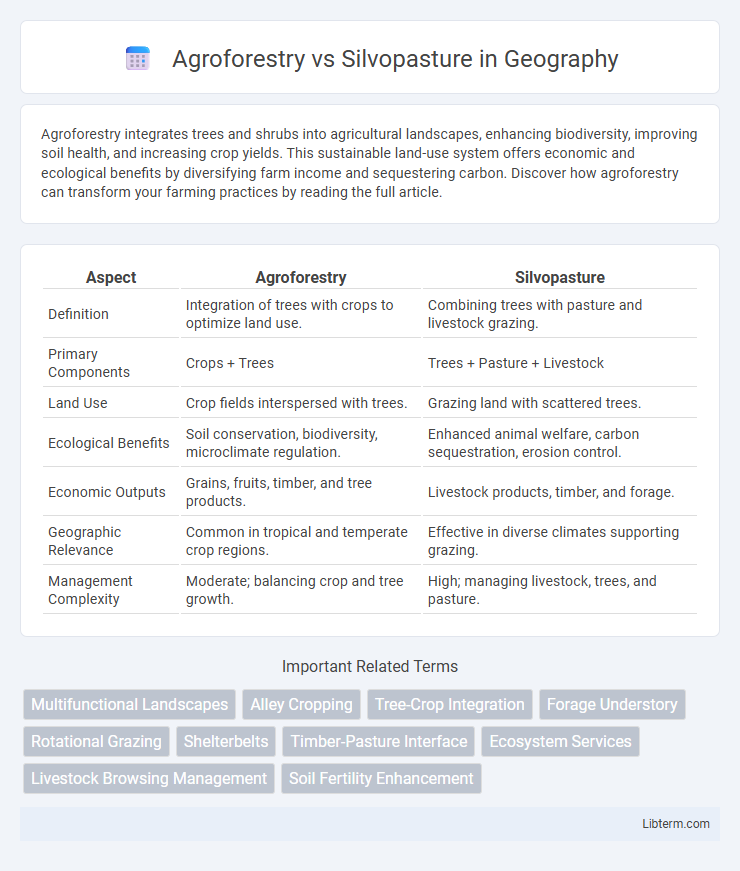Agroforestry integrates trees and shrubs into agricultural landscapes, enhancing biodiversity, improving soil health, and increasing crop yields. This sustainable land-use system offers economic and ecological benefits by diversifying farm income and sequestering carbon. Discover how agroforestry can transform your farming practices by reading the full article.
Table of Comparison
| Aspect | Agroforestry | Silvopasture |
|---|---|---|
| Definition | Integration of trees with crops to optimize land use. | Combining trees with pasture and livestock grazing. |
| Primary Components | Crops + Trees | Trees + Pasture + Livestock |
| Land Use | Crop fields interspersed with trees. | Grazing land with scattered trees. |
| Ecological Benefits | Soil conservation, biodiversity, microclimate regulation. | Enhanced animal welfare, carbon sequestration, erosion control. |
| Economic Outputs | Grains, fruits, timber, and tree products. | Livestock products, timber, and forage. |
| Geographic Relevance | Common in tropical and temperate crop regions. | Effective in diverse climates supporting grazing. |
| Management Complexity | Moderate; balancing crop and tree growth. | High; managing livestock, trees, and pasture. |
Introduction to Agroforestry and Silvopasture
Agroforestry integrates trees and shrubs with crops and livestock on the same land to enhance biodiversity, improve soil health, and increase agricultural productivity. Silvopasture, a specialized form of agroforestry, combines forestry with livestock grazing, promoting sustainable land management by optimizing tree cover and pasture use. Both practices contribute to carbon sequestration, erosion control, and diversified income streams for farmers.
Core Principles of Agroforestry
Agroforestry integrates trees and shrubs with crops or livestock to enhance biodiversity, optimize resource use, and improve ecosystem services such as soil fertility and water retention. Core principles include spatial and temporal arrangement of plant species to maximize productivity and sustainability, promoting ecological balance by combining complementary interactions among trees, crops, and animals. This strategic diversification supports resilience against climate variability, boosts agricultural output, and fosters long-term environmental health.
Key Features of Silvopasture Systems
Silvopasture systems integrate trees, forage plants, and livestock in a mutually beneficial arrangement to enhance productivity and sustainability. Key features include strategic tree spacing to optimize sunlight for pasture growth, selection of tree species providing shade, timber, or fodder, and rotational grazing practices that promote soil health and reduce overgrazing. This system improves animal welfare through shade, increases biodiversity, and offers diversified income streams by combining livestock and forestry products.
Comparative Benefits for the Environment
Agroforestry integrates trees with crops, enhancing biodiversity, reducing soil erosion, and improving carbon sequestration more effectively than conventional farming. Silvopasture combines trees with livestock grazing, which promotes better nutrient cycling, reduces pasture degradation, and increases wildlife habitat diversity. Both practices contribute significantly to climate resilience, but silvopasture offers improved forage quality and animal welfare under tree canopies, while agroforestry excels in diversified crop production and soil health.
Impacts on Soil Health and Biodiversity
Agroforestry integrates trees with crops, enhancing soil health by increasing organic matter, improving nutrient cycling, and reducing erosion, while promoting diverse habitats that support a wide range of flora and fauna. Silvopasture combines trees with livestock grazing, which strengthens soil structure through root systems, enriches soil nutrients via manure, and fosters biodiversity by creating varied microhabitats for plants, insects, and wildlife. Both practices boost ecosystem resilience but differ in their impact intensity, with silvopasture offering unique benefits through animal-plant-soil interactions that intensify nutrient dynamics and biodiversity conservation.
Economic Advantages and Profitability
Agroforestry integrates trees with crops to diversify income streams, reduce risks, and improve long-term soil health, enhancing farm profitability through diversified products like fruits, nuts, and timber. Silvopasture combines trees with livestock grazing, increasing land-use efficiency and generating revenue from both animal products and timber, often leading to higher overall returns per acre compared to conventional pasture or cropland. Studies indicate silvopasture systems can boost farm income by up to 30% by optimizing forage production, livestock performance, and timber sales simultaneously.
Livestock Integration: Silvopasture vs Agroforestry
Silvopasture integrates livestock grazing with tree and pasture management, enhancing animal welfare and productivity through shade, shelter, and diverse forage availability. Agroforestry systems may include livestock but emphasize tree-crop interactions more broadly, often without consistent grazing practices. Silvopasture optimizes livestock integration by balancing tree density and pasture quality, promoting sustainable animal nutrition and ecosystem benefits.
Challenges and Implementation Barriers
Agroforestry faces challenges such as complex land-use planning, higher initial investment costs, and longer time horizons for economic returns, which can deter adoption by farmers. Silvopasture implementation barriers include managing the interactions between trees, forage, and livestock, addressing animal health concerns related to tree species, and the need for specialized knowledge to balance productivity. Both systems require overcoming institutional constraints, lack of technical support, and market access issues to enable wider uptake in sustainable agriculture.
Case Studies and Regional Applications
Case studies in agroforestry reveal diverse regional applications, such as in Brazil's Amazon Basin where agroforestry integrates timber and crop production to enhance biodiversity and soil health. Silvopasture examples in the southeastern United States demonstrate improved livestock weight gain and pasture resilience through combining trees, forage, and grazing animals. These regional models showcase how agroforestry and silvopasture optimize land use, increase farm profitability, and contribute to sustainable environmental management.
Choosing the Right System for Your Land
Selecting between agroforestry and silvopasture depends on your land's topography, soil type, and intended agricultural goals. Agroforestry integrates trees with crops to enhance biodiversity and soil health, ideal for lands prioritizing crop diversity and conservation. Silvopasture combines trees with livestock grazing, best suited for open pastures where animal production and shade management improve overall farm productivity.
Agroforestry Infographic

 libterm.com
libterm.com